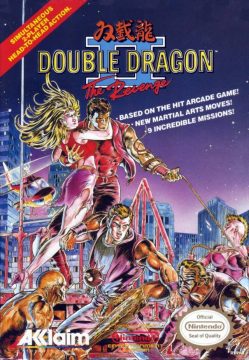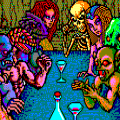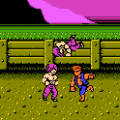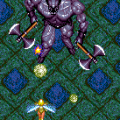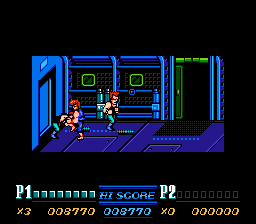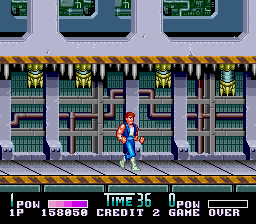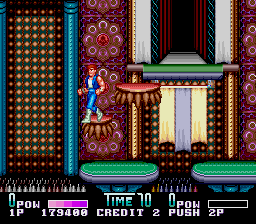- Double Dragon
- Double Dragon (NES / Game Boy)
- Double Dragon 2 (Arcade)
- Double Dragon II (NES/PCE)
- Double Dragon 3 (Arcade)
- Double Dragon III (NES)
- Double Dragon II (Game Boy)
- Super Double Dragon
- Double Dragon: The Revenge of Billy Lee
- Double Dragon V
- Double Dragon (Neo Geo)
- Rage of the Dragons
- Double Dragon Advance
- Double Dragon (Mobile)
- Double Dragon II: Wander of the Dragons
- Double Dragon (Zeebo)
- Abobo’s Big Adventure / Fighting of Double Dragon
- Double Dragon Neon
- Double Dragon IV
- Double Dragon: Other Media
Technōs created once again a vastly different experience with Double Dragon II on the NES. The experience system was dropped, but the moveset still underwent a few changes. The elbow attack and turning jump kick are gone, but with the standard kick directed backwards they seemed a bit redundant anyway. There are two new ways to make enemies in a grapple suffer, elbow smashes to the head, and a high kick to propel them away. In the brief time window when the Lee brothers are crouching after a jump or after getting knocked down, it’s possible to perform a rising uppercut or a knee jump attack. The timing for these isn’t easy, but they are the most powerful moves in the game.
On the NES, Double Dragon II is a much more innovative and unique sequel than in the arcade, but it marks also the time Double Dragon started its schizophrenic shifting between wildly different tones and gameplay styles. In a way it’s one of the best games to bear the Double Dragon name, but it’s hard to shake the feeling that Technōs had already started to loose a cohesive vision of what it meant to be Double Dragon, both in tone and in gameplay.
The game starts out on a military base like the arcade, but then you get to chase a helicopter across some rooftops, and then fight within the helicopter as the door keeps opening and closing, with the air suction drawing Lee brothers and enemies alike outside. This is followed by a high-tech underground facility with severely limited movement, as not only confines you to a single line but also prohibits jumping with a row of spikes on the low ceiling. The crop field is replaced by yet another forest/mountain stage like in the first game, but it leads to a fight on a giant track vehicle that has to be climbed while it is moving back and forth on the screen.
The latter half almost seems like it wants to be a best of 8-bit platformers, with conveyor belts, cyclically disappearing platforms like in Mega Man and a Castlevania-style clockwork segment. One level ends with a big fight on an enormous bulldozer, which keeps moving back and forth, making it harder to get up to your foes. There is also an exciting screen where the floor starts crumbling down from behind and you have to defeat a bunch of opponents before there is no floor left to stand on. Almost half of the game now takes place on a single 2D lane rather than the semi-3D angular perspective the beat-em-up genre is known for.
The NES version of Double Dragon II is the first game in the series to actually spell out explicitly that the setting is a post-apocalyptic near future version of New York, taking place in the year “19XX” after a nuclear war. It’s the first to spell out a lot of things, in fact, as there are short transitional texts after every stage. Even though it still follows the narrative of Marion getting killed by the Black Shadow Warriors, Willy doesn’t appear at all in this game. Things instead get supernatural, so the Lee brothers get transported to an otherworldly plane with a demon in the background, where they must fight an ominous shadow warrior, who looks more like a prototype for Wolfgang Krauser from SNK’s Fatal Fury 2 with his cape, and he’s just as mean in a fight as the SNK boss. Defeating him causes an angel to descend from heaven to revive Marion.
However, you only get to fight the penultimate boss on Supreme Master mode, the highest of three difficulty levels. Practice mode is over after level three, and Warrior mode stops just short of the final encounter. But even on the highest setting the game isn’t too hard compared to the arcade versions, especially after mastering the timing for the knee attack, which sends enemies flying down pits in an instant. The platforming segments demand a little more precision than the game seems to be built for, and the many instant kills are a bit much, but once getting used to the stiff jump length, they become quite surmountable. The only really hard parts are the stage with the spikes that prevent jumping, an extremely annoying boss fight against two super fast, shuriken-throwing martial artists who are extremely hard to catch, and the final boss whose special attack can kill a Lee brother in three hits. Otherwise the health bar is extremely generous, although you don’t get another chance at continuing after losing all three lives – unless you put in a special code at the Game Over screen, which also differs between stages.
As so often in NES action game localizations, the Japanese version has none of that sadistic nonsense – here you can continue normally, and you get to play the entire game no matter which difficulty you choose. The Famicom version also has the kindness to adjust the difficulty of the disappearing platforms accordingly.
In contrast to the first NES game, Double Dragon II finally lets two players seek revenge together, even allowing the choice whether or not the brothers can hurt each other by accident. Otherwise it is subject to the same technical limitations, so once again there is no mixing of enemies and no more than two of them on screen at a time. The 1-on-1 mode from the first game is gone, too.
The PC Engine CD version by Naxat Soft is surprisingly modeled closely after the NES game, from featuring mostly the same levels down to the rule of having no more than two enemies on screen at a time. But it does mix and match different types together, and in general extends the stages with additional hoodlums. There are a few other notable structural differences – namely, the fight on the huge moving bulldozer at the end of the forest level is missing, but to make up for its omission, the Lee brothers actually have to fight Willy before they meet their own shadows like in the arcade game. They also get to face the Shadow Master (now without the cape) on any difficulty level, although you miss out on the second round in a church and the good ending with Marion revived unless you beat the game on the Hard difficulty mode.
The game is no slouch even on easy, though. The hit detection has shifted a bit in your favor and most standard foes are easily disposed of, but there are exceptions. Fighting Chin with his far jump kicks and foot swipes on a single lane is still no fun, the shadows spend a lot of time off screen and suck out almost all health when they possess the Lee brother’s bodys and the final boss still has totally unfair priorities, plus he is now invisible for most of the fight. At least the life counting is a bit more lenient than the NES version – the options menu lets you increase both lifes and continues up to five each.
The biggest difference comes with the new presentation. The characters are drawn in a far less cartoony style even compared to the arcade game, making this version almost look like a Westernized DOS version. Especially the large opponents are a lot more impressive with the realistic proportions, although Abobo now looks like a sexy vampire for some reason.


